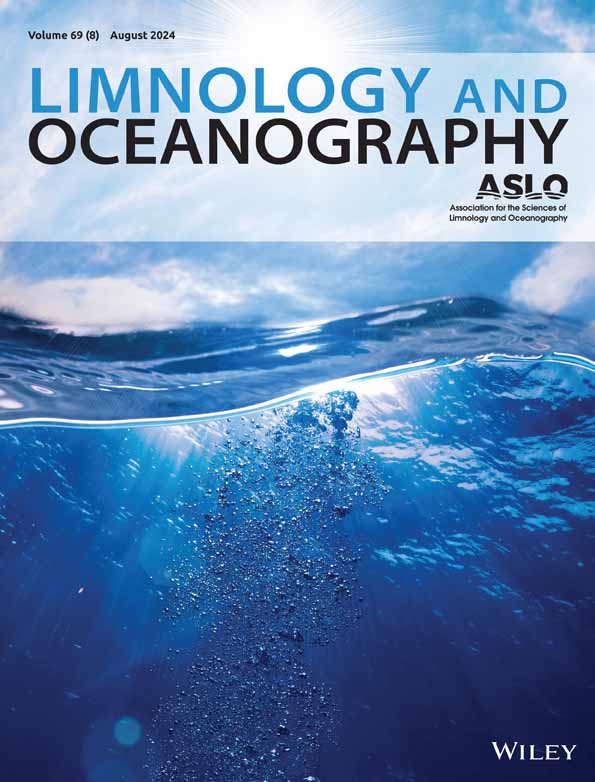一条大型碱性河流30年无机碳动态及其与自养群落制度变迁的关系
IF 3.8
1区 地球科学
Q1 LIMNOLOGY
引用次数: 0
摘要
自来水中多余的二氧化碳有多少来自于有机碳的呼吸作用?为了回答这个问题,我们以每小时的分辨率为法国卢瓦尔河(一条大型碱性河流)开发了一个30年的代谢-碳酸盐系统数据库。我们提出了以下问题:什么是溪流(“内部”)二氧化碳生产的年内模式,什么过程驱动这些模式,以及这些模式如何依赖自养群落组成?我们估计内部CO2产量为净生态系统产量与CO2水-空气通量(FCO2)的比值。我们还估算了二氧化碳消耗下的每日生态系统商(EQ, O2释放:溶解无机碳[DIC]消耗)和非CO2自养DIC吸收途径的流行情况。从1990年到2022年,卢瓦尔河内部二氧化碳产量中位数占总二氧化碳的49%。作为排放的函数,河流可预见地从异养型二氧化碳源转变为自养型二氧化碳汇,导致四种营养通量(“营养通量”)状态:自养型汇、自养型源、异养型汇和异养型源。在自养状态(41%的时间),CO2消耗(FCO2≤0,中位数pCO2 = 135 μatm)导致CaCO3降水释放的CO2被用作自养生物的替代DIC来源,以支持其高初级生产速率(平均在生长季节的33%发生)。最后,在浮游植物优势期,EQ中值为1.3,而在大型植物优势期,EQ中值降至1.0。这项工作描述了自养群落、碳酸钙平衡和排放控制的FCO2之间的动态耦合,这些耦合共同意味着卢瓦尔河的FCO2强度低于预测,而内部CO2产量高于预测。本文章由计算机程序翻译,如有差异,请以英文原文为准。
Inorganic carbon dynamics and their relation to autotrophic community regime shift over three decades in a large, alkaline river
How much of the excess CO2 in running waters comes from in‐stream respiration of organic carbon? To answer this, we developed a 30‐yr metabolism‐carbonate system database at an hourly resolution for the Loire River, France, a large, alkaline river. We asked the following questions: what are the intra‐annual patterns of in‐stream (“internal”) CO2 production, what processes drive these patterns, and how do these patterns depend on autotrophic community composition? We estimated internal CO2 production as the ratio of net ecosystem production to CO2 water‐to‐air flux (FCO2 ). We also estimated the daily ecosystem quotient (EQ, O2 released: dissolved inorganic carbon [DIC] consumed) and the prevalence of non‐CO2 autotrophic DIC uptake pathways under CO2 depletion. Median internal CO2 production was 49% of FCO2 in the Loire from 1990 to 2022. The river predictably shifted from a heterotrophic, CO2 source to an autotrophic, CO2 sink as a function of discharge, leading to four trophic‐flux (“trophlux”) states: autotrophic‐sink, autotrophic‐source, heterotrophic‐sink, and heterotrophic‐source. During autotrophic states (41% of the time), CO2 depletion (FCO2 ≤ 0, median pCO2 = 135 μ atm) led to the use of and of CO2 released by CaCO3 precipitation as alternative DIC sources to autotrophs to support their high rates of primary production (occurring on average for 33% of the growing season). Finally, during a period of phytoplankton dominance, the median EQ was 1.3, which was reduced to 1.0 under macrophyte dominance. This work describes a dynamic coupling among autotrophic communities, calcium carbonate equilibria, and discharge‐controlled FCO2 that together imply lower‐than‐predicted FCO2 magnitude and greater‐than‐predicted internal CO2 production for the Loire River.
求助全文
通过发布文献求助,成功后即可免费获取论文全文。
去求助
来源期刊

Limnology and Oceanography
地学-海洋学
CiteScore
8.80
自引率
6.70%
发文量
254
审稿时长
3 months
期刊介绍:
Limnology and Oceanography (L&O; print ISSN 0024-3590, online ISSN 1939-5590) publishes original articles, including scholarly reviews, about all aspects of limnology and oceanography. The journal''s unifying theme is the understanding of aquatic systems. Submissions are judged on the originality of their data, interpretations, and ideas, and on the degree to which they can be generalized beyond the particular aquatic system examined. Laboratory and modeling studies must demonstrate relevance to field environments; typically this means that they are bolstered by substantial "real-world" data. Few purely theoretical or purely empirical papers are accepted for review.
 求助内容:
求助内容: 应助结果提醒方式:
应助结果提醒方式:


